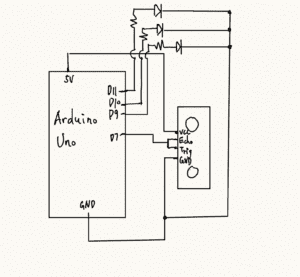Circuit: Distance Detector

Components:
1 * Arduino Uno
1 * USB-B to USB-A cable
1 * HC-SR04 Ultrasonic Sensor
3 * LED
3* 220 ohm resistors
Several jumper cables
Video:
Process:
I picked the ultrasonic sensor simply because it looks cool, just like a stereo speaker. Before building our circuit, we first used the code here to test how the sensor works. At the very beginning, the distance it detected was not stable, with the maximum figures reaching more than 3000cm. But later we found out that we need to connect both pins in the middle to the digital input on Arduino and the problem was then solved. After getting to know the features of the ultrasonic sensor, we began to build a circuit that could light up based on the readings of the ultrasonic sensor. The circuit itself is not a very difficult one and the schematic is quite clear, as you can see above. For the code part, we based on the code in the “Ping” example and added a few lines to control the LED. By using ‘if’ statements, no LEDs would light when the object is over 50cm away. The green LED will be on when the object is less than 50cm away, the yellow one will be on at 30cm and the red one will be on at 10cm.
Question 1:
We intended to assemble a distance detector that could light up different LEDs based on the distance between the sensor and the object. I think it may serve as a helper when drivers need to park their cars. With this detector, they would be able to know how much room do they still have in the front or at the back side their cars so they are unlikely to hit barriers or other cars. Of course, this circuit would be better if we integrate a buzzer because sound may be more intuitive than lights.
Question 2:
I think this statement is true. We are unlikely to cook delicious meals or master a skill merely based on a recipe or tutorial. That kind of material only offers us basic knowledge and so are the codes in Arduino. It is often the case that we need to make some modifications to the code so the circuit would be better of practical use. In each example of Arduino, we can see that the author often attaches remarks on what the specific code is for. This gives us much convenience when we need to modify our code by ourselves.
Question 3:
In my opinion, one of the most significant influences is that human beings tend to spend more time interacting with machines rather than people. With the help of computers, it is easier for us to connect with anyone in the world and we less treasure the time we spend with our close friends or families. The endless, dazzling information on the internet tend to get us immersed and we merely have time to care about the people around us. As a result, citizens of contemporary society, when deep in the dark and still awake, are more likely to have lonely feelings than they used to be. Someone may argue that this is the new norm in the internet age but I think the time I spent with the people around me is the most precious thing that I could have.